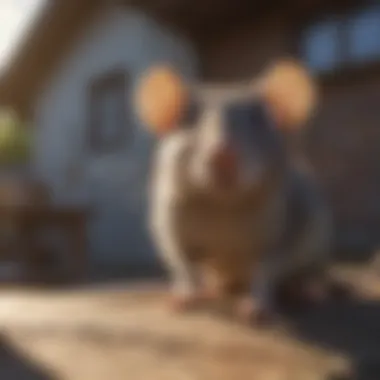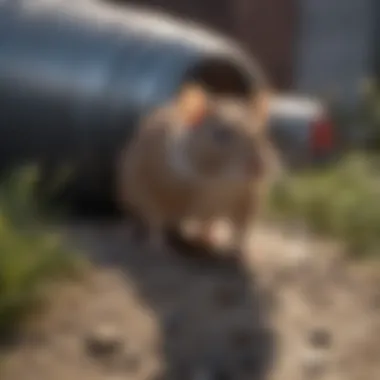Effective Strategies for Eliminating Roof Rats: A Comprehensive Guide


Preventive Pest Control Strategies Ensuring your property remains free from roof rats involves investing time in thorough preventive pest control strategies. Protecting the exterior of your house plays a crucial role in deterring these pests. Begin by sealing any visible cracks or crevices that may serve as entry points for roof rats. Conduct regular checks around your property, ensuring no debris accumulates near your home, as this can attract pests. Implement measures to prevent pests from finding their way into your living spaces by installing door sweeps and repairing damaged screens. When it comes to yard maintenance, focus on essential routines that create an inhospitable environment for pests. Keep your yard well-groomed and free of overgrown vegetation that can harbor roof rats. Implement methods such as proper waste disposal and minimizing standing water to ward off these unwanted intruders. Maintaining cleanliness indoors is equally vital. Adopt expert cleaning tips and techniques to eliminate potential hiding spots for roof rats. Establish a pest-resistant atmosphere indoors by promptly fixing any plumbing leaks and storing food in airtight containers. Proper garbage disposal is a fundamental aspect of pest control. Explore efficient waste disposal methods to prevent attracting roof rats seeking food sources. Understand the importance of disposing garbage correctly to reduce the likelihood of pest infestations. Utilize innovative strategies beyond traditional methods to safeguard your home against roof rats and other pests, ensuring comprehensive protection.
Understanding Roof Rats
In this article, the emphasis is on elucidating the significance of understanding roof rats in the context of effectively eradicating these pests from residential spaces. Knowledge about roof rats is pivotal for implementing targeted elimination strategies. By comprehending the behavior, habits, and risks associated with roof rats, individuals can devise and execute precise control measures with efficiency and efficacy. Understanding roof rats equips homeowners with the necessary information to safeguard their properties from infestations, fostering a rat-free environment conducive to health and well-being.
Identifying Roof Rats
Identifying roof rats can be a challenging yet crucial task in rat control. Roof rats, also known as black rats, are medium-sized rodents with long tails, pointed noses, and large ears. They typically measure around 13 to 18 inches in length, including their tail. These rats exhibit a sleek body structure and are agile climbers, often found scurrying around roofs, attics, and upper levels of buildings. Distinguishing features include smooth fur, spindle-shaped droppings, and gnaw marks on surfaces. Conducting thorough inspections of potential nesting sites and observing nocturnal activities can aid in accurately identifying roof rats infesting a property.
Behavior and Habits
Understanding the behavior and habits of roof rats is fundamental in devising effective control strategies. Roof rats are nocturnal creatures, primarily active during the night, foraging for food and building nests. They are omnivorous, feeding on various sources, including fruits, nuts, grains, and insects. Roof rats exhibit neophobic tendencies, being wary of new objects or changes in their environment. Their agility and intelligence make them adept at evading traps and accessing hard-to-reach areas, enhancing their adaptability to urban settings. Recognizing their nesting preferences and movements patterns enables homeowners to implement preventive measures and targeted trapping methods to mitigate infestations.
Risks Associated with Roof Rats
Understanding the risks associated with roof rats is imperative for fostering a safe and hygienic living environment. Roof rats pose health hazards through the contamination of food and water sources with feces, urine, and hair, potentially transmitting diseases to humans. Their gnawing behavior can damage property structures, electrical wiring, and insulation, increasing the risk of fire hazards and structural integrity issues. Moreover, roof rat infestations can lead to psychological distress and anxiety among occupants due to the perceived threat to hygiene and well-being. By comprehending the risks posed by roof rats, homeowners can prioritize proactive measures to eradicate these pests and mitigate potential hazards effectively.
Preventive Measures


In the journey towards eradicating roof rats from your property, implementing preventive measures stands as a crucial pillar. These measures serve as the proactive shield guarding your household against potential rat infestations. By incorporating these strategies, homeowners can significantly reduce the risk of roof rats finding their way into the premises. Preventive measures not only address the current rat issues but also aim to prevent future invasions, ensuring a rat-free environment for the long term.
Emphasizing the importance of preventive measures in this article is paramount due to their efficacy in establishing a barrier against roof rats. Homeowners need to understand that taking proactive steps is more effective and economical compared to dealing with rat infestations after they have already occurred. By educating readers on the significance of these measures, this guide equips them with the knowledge needed to safeguard their property effectively.
Sealing Entry Points
One of the fundamental aspects of preventing roof rat infestations is sealing off all possible entry points into the house. Roof rats are adept at squeezing through even the tiniest of openings, making it imperative to conduct a thorough inspection of the property. By identifying and sealing gaps, cracks, and openings in walls, roofs, doors, and windows, homeowners can reduce the chances of rats gaining access to their homes.
Implementing an effective sealing strategy involves utilizing materials such as steel wool, wire mesh, and caulk to seal off entry points. It is essential to pay close attention to areas where utility lines enter the house, as rats often use these openings to enter the building. By diligently sealing entry points, homeowners create a fortified barrier that deters roof rats and prevents them from infiltrating the premises.
Proper Food Storage
Proper food storage practices play a pivotal role in deterring roof rats from invading homes. These rodents are attracted to readily available food sources, making kitchens and pantries prime targets for infestation. By storing food items in airtight containers made of durable materials such as glass or metal, homeowners can deprive rats of easy access to their food supply.
Furthermore, it is essential to clean up spills promptly, dispose of garbage regularly, and avoid leaving pet food out overnight. By eliminating potential food sources, homeowners make their properties less appealing to roof rats, prompting these rodents to seek nourishment elsewhere. By incorporating proper food storage habits into their daily routine, homeowners significantly reduce the likelihood of attracting roof rats to their homes.
Maintaining Cleanliness
Maintaining a high standard of cleanliness is instrumental in preventing roof rat infestations. These rodents thrive in dirty and cluttered environments, making it essential for homeowners to keep their living spaces clean and organized. Regularly sweeping, vacuuming, and decluttering the house not only improves overall hygiene but also eliminates hiding spots for roof rats.


Additionally, addressing moisture issues such as leaks and standing water helps in deterring rats, as these pests are attracted to damp environments. By upholding cleanliness standards both indoors and outdoors, homeowners create an inhospitable habitat for roof rats, discouraging them from taking up residence on the property. Prioritizing cleanliness is a fundamental preventive measure that significantly contributes to maintaining a rat-free environment.
Natural Repellents
Peppermint Oil
Peppermint oil stands out as a potent natural repellent against roof rats due to its strong scent that rats find repulsive. The intense aroma of peppermint oil overwhelms the rodents' sense of smell, making the environment inhospitable for them. By strategically placing cotton balls soaked in peppermint oil in areas prone to rat activity, individuals can create a barrier that deters these pests effectively. Additionally, peppermint oil is a safe and pleasant-smelling alternative to traditional rat repellents, ensuring that the living spaces remain fresh and aromatic while keeping rodents at bay.
Predator Urine
Another natural repellent worth considering in the battle against roof rats is predator urine. When roof rats detect the scent of predator urine, their survival instincts kick in, triggering a fear response that drives them away from the perceived danger zone. By strategically placing predator urine in strategic locations around the property, homeowners can create a natural deterrent barrier that discourages rat infestations. Predator urine serves as a biological signal that communicates a potential threat to roof rats, compelling them to seek safer environments away from the property.
Plants That Deter Roof Rats
Certain plants possess natural properties that repel roof rats due to their strong scents or textures. For example, plants like lavender, daffodils, and marigolds emit fragrances that rats find unpleasant, leading them to avoid areas where these plants are present. Additionally, plants with thorny or prickly leaves act as physical barriers that deter rats from accessing specific areas of the property. By incorporating these rat-repelling plants into landscaping or garden design, individuals can create a natural defense system against roof rats, enhancing the overall effectiveness of their pest management efforts.
Trapping Methods
Trapping methods are a crucial aspect of effectively eliminating roof rats from your property. In this section, we will delve into the importance of utilizing trapping methods, understanding the specific elements, benefits, and considerations associated with them. Trapping methods serve as a proactive approach to tackling roof rat infestations, offering a targeted and efficient way to remove these pests from your premises.


Snap Traps
Snap traps are a traditional yet highly effective method for capturing roof rats. These traps work by snapping shut when triggered by the rat, swiftly and humanely eliminating the pest. When setting up snap traps, it is essential to place them strategically in areas frequented by roof rats, such as along walls or near entry points. Using bait that is attractive to roof rats, such as peanut butter or dried fruit, can increase the trap's effectiveness.
Snap traps are beneficial due to their affordability, ease of use, and quick results. However, they require regular checks to ensure captured rats are promptly disposed of to prevent odors and potential health hazards. Additionally, it is important to follow safety precautions while handling snap traps to avoid any injuries.
Live Traps
Live traps offer a more humane approach to dealing with roof rat infestations. These traps capture rats alive, allowing you to release them back into the wild unharmed. Live traps are ideal for individuals who prefer to avoid causing harm to animals or those seeking a catch-and-release solution.
When using live traps, it is crucial to select the right size trap to ensure it is suitable for capturing roof rats. Placing these traps strategically in areas where roof rats frequent, along with bait such as nuts or fruit, can increase their effectiveness. Once a rat is captured, it should be released far away from your property to prevent its return.
Live traps are favored for their ethical approach to pest control and minimal risk of injuring children or pets. However, they require regular monitoring to prevent captured rats from experiencing distress or harm while confined. It is important to regularly check live traps and release any captured rats promptly to maintain their welfare.
Professional Extermination
When it comes to getting rid of stubborn roof rats that have infested your property, professional extermination stands out as a crucial and effective solution. Professional extermination services bring a level of expertise and equipment that can efficiently tackle even the most severe rat problems. These professionals are trained to identify the extent of the infestation, locate entry points, and implement targeted strategies for eradication.
One key benefit of opting for professional extermination is the thoroughness of the process. Pest control experts have the knowledge and experience to not only eliminate existing roof rats but also to prevent future infestations. By employing industry-approved techniques and treatments, they ensure that your property is thoroughly inspected and treated to eradicate rats completely.
Moreover, professional extermination services save time and effort for homeowners. Dealing with a rat infestation can be challenging and time-consuming, especially when employing DIY methods that may not be as effective. Professional exterminators streamline the process, swiftly addressing the issue and providing long-lasting results.
It's important to consider certain factors before choosing a professional extermination service. Ensure that the company is licensed and has a good reputation for effective pest control. Ask about the techniques they use, ensuring they are safe for your family and pets. Additionally, inquire about the type of guarantee or warranty they offer to ensure that the problem is resolved satisfactorily.
By entrusting the task of rat extermination to professionals, homeowners can enjoy a rat-free environment without the hassle and stress of tackling the problem alone. Professional extermination not only resolves the immediate rat issue but also provides peace of mind knowing that experts have safeguarded the property against potential future infestations.



